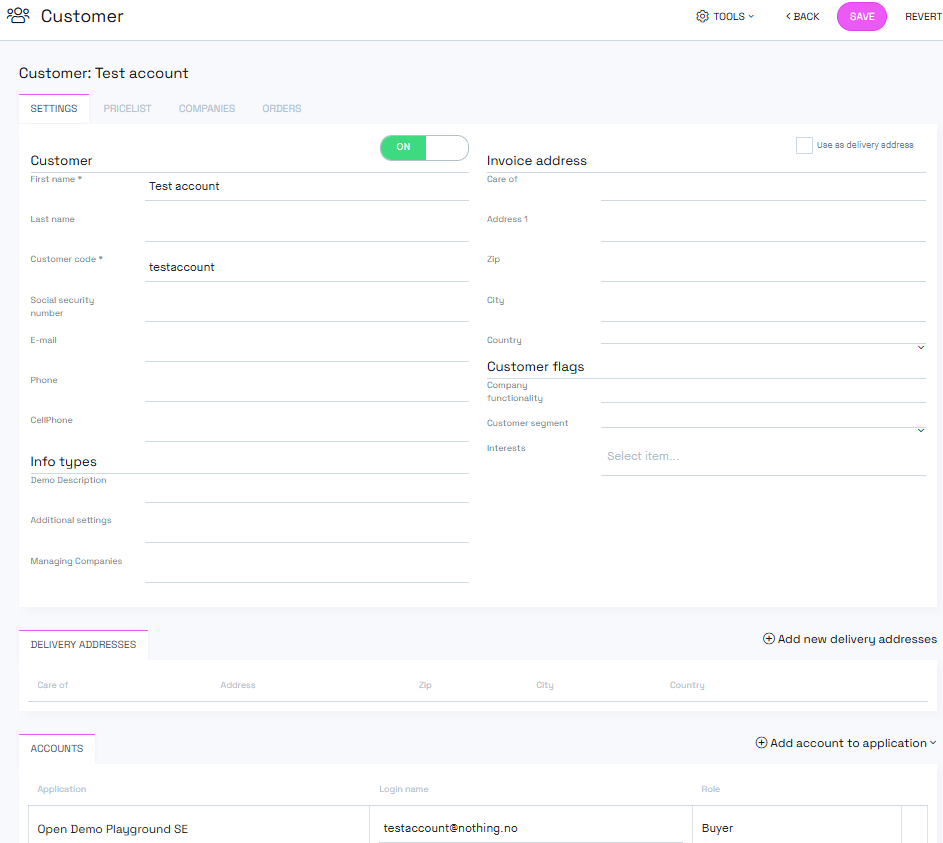Customers are fundamental entities in Norce Commerce, representing individual people who interact with your business. They serve as the foundation for order handling, account creation, and customer relationship management throughout your commerce platform.

In Norce Commerce, customers serve multiple purposes:
- Individual identity management: Customers are always individuals (people), not organizations or companies
- Order processing: Enable both direct consumer purchases and B2B order contacts
- Account management: Provide foundation for front-end login functionality
- Customer segmentation: Support classification and targeting through flags and custom fields
The customer page displays a list of active customers by default, either for the entire client or specifically for an application (configurable at the client level). You can sort and search this list to find specific customers.
Note: Organizations and companies are managed in a separate registry. Customers can make purchases for themselves or act as contacts for business-to-business orders.
To create a customer, you need the following essential information:
- Email address: Serves as the unique identifier for customers
- First name and Last name: Basic personal identification
When viewing or creating a customer, the main settings tab contains comprehensive customer information organized into several key areas.
- First name and Last name: Basic identity fields
- Customer code: External identifier that can be user-defined or auto-generated by Norce
- Email address: Primary unique identifier and communication channel
- Phone information: Contact details for customer communication
- Invoice address: Primary billing address for order processing
- Use as delivery address: Checkbox to use invoice address for delivery
- Delivery addresses: Add multiple delivery addresses when invoice address is not used for delivery
Important: The country dropdown list is restricted to countries that have been configured for the application. If a required country is missing, you will need to add it to the application's country settings first.
Tag customers with custom flags for segmentation and classification purposes:
- VIP status and loyalty program membership
- Interest categories and preferences
- Special customer qualities and attributes
Customer flags enable:
- Filtering and reporting: Create targeted customer lists and analytics
- Integration purposes: Support external system workflows
- Promotion targeting: Restrict offers to specific customer segments and groups
Extendable fields that allow you to add custom fields to the customer model:
- Store additional customer data beyond standard fields
- Support business-specific requirements
- Enable custom reporting and segmentation
Create account entities for customers to enable front-end login functionality:
- One account per application limit enforced
- Login name: Defaults to email address but can be changed
- Role assignment: Managed under customer settings for access control
- Application assignment: Required field linking account to specific application
Accounts provide:
- Password hashing in secure storage
- Login validation from front-end applications calls
- Integration capability with third-party authorization solutions
Important: Customer accounts are not to be confused with admin users. Admin users are accounts that can log into the admin UI, while customer accounts are specifically for front-end application logins.
While customers are typically created automatically through the purchase process via APIs, you can manually create new customers through the admin interface when needed for:
- Manual order entry
- Customer service scenarios
- Testing and development purposes
Manage customer status through the listing interface:
- Click the X button on the right side of the customer in the list
- Confirm your decision when prompted
- Deactivated customers are moved to the bin and can be viewed by selecting "inactive" in the status filter
- Reactivate customers if needed through the inactive customer view
- Active customers: Default view showing all currently active customers
- Inactive customers: Accessible through status filter, showing deactivated accounts
- Reactivation: Simple process to restore customer access when needed
Similar to other Norce modules, customers support comprehensive reporting capabilities under the Tools menu:
- Edit columns: Customize data views for specific needs
- Save reports: Store frequently used report configurations
- Create dashboard widgets: Build visual representations of customer data
- Generate custom reports: Develop detailed analytics and insights
- Export capabilities: Extract customer data for external analysis
- Bulk operations: Perform mass updates on customer records
- Search and filtering: Quickly locate specific customers or customer segments
Note: Read about GDPR and anonymizing functionality here.
- Implement VIP and loyalty program classifications
- Create interest-based customer groups
- Support targeted marketing campaigns
- Enable personalized customer experiences
- Assign customers as company contacts
- Manage multiple delivery addresses for business accounts
- Support complex pricing and approval workflows
- Enable role-based access for business users
Note: Customer management integrates with various Norce modules including order handling, promotions, and external systems. Always consider the broader impact when making structural changes to your customer configuration.